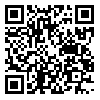1. Shahyad A. The Relationship between Attachment Style, Quality of Life and Justify Extramarital Relations. Studies in Psychology and Educational Sciences. 2017;3(1/1):76–90. [Persian] [
Article]
2. Tsapelas I, Fisher HE, Aron A. Infidelity: When, Where, Why. In: Cupach WR, Spitzberg BH. The Dark Side of Close Relationships II. New York : Routledge; 2011. pp: 175–96.
3. Fincham FD, May RW. Infidelity in romantic relationships. Curr Opin Psychol. 2017;13:70–4. [
DOI]
4. Ejtehadi M, Vahedi G. Barrasi Jame-shenakhti potansiel khianat dar ravabet zanashouie va avamel moaser bar an dar beyn karmandan edarat dolati va khosousi [Sociological study of the potential of betrayal in marital relations and its influential factors among public and private employees]. Iranian Sociological Association;2016;17(4):105–38. [Persian] [
Article]
5. Behrad Far R, Jazayeri R, Bahrami F, Abedi MR, Etemadi O, Fatemi SM. A comparative scrutiny of the effectiveness of Emotionally-Focused Couple Therapy (EFCT) and Narrative Couple Therapy (NCT) in the marital quality and emotional, cognitive and behavioral impaired functioning of distressed couples. Journal of Family Psychology. 2016 ;3(1):3–16. [Persian] [
Article]
6. Previti D, Amato PR. Is infidelity a cause or a consequence of poor marital quality? Journal of Social and Personal Relationships. 2004;21(2):217–30. [
DOI]
7. Angusamy A, Kuppusamy J, Anantharaman RN, Syafiqah S. A study on marital satisfaction among Malaysian women. International Journal for Studies on Children, Women, Elderly And Disabled. 2017;1:85–89.
8. Dizjani F, Kharamin S. Reality therapy effect on marital satisfaction and women’s quality of life. Armaghane danesh. 2016;21(2):187–99. [Persian] [
Article]
9. Abbasi H, Ahmadi SA, Fatehi Zadeh M, Bahrami F. The effect of Glaser’s reality therapy on personal commitment of couples. Family Pathology, Counseling and Enrichment Journal. 2016;2(1):39–53. [Persian] [
Article]
10. Zarei E, Borumand R, Sadeghifard M, Najarpourian S, Askari M. Effectiveness of group counseling based on choice theory on increasing intimacy and marital satisfaction and reducing marital conflicts in married women. Hormozgan Medical Journal. 2017;21(4):250–9. [Persian] [
DOI]
11. Johnson SM, Greenberg LS. Differential effects of experiential and problem-solving interventions in resolving marital conflict. Journal of Consulting and Clinical Psychology. 1985;53(2):175–84. [
DOI]
12. Etemadi A, Ahmad Barabadi H. The effectiveness of emotionally focused group couple therapy on marital satisfaction in couples referred to counseling center education district 2 Mashhad. Research in Clinical Psychology and Counseling. 2014;4(1):95–114. [Persian] [
Article]
13. Glasser W. Fibromyalgia: Hope from a completely new perspective. Chatsworth, CA: William Glasser, Inc; 2001.
14. Greenberg L, Warwar S, Malcolm W. Emotion-focused couples therapy and the facilitation of forgiveness. J Marital Fam Ther. 2010;36(1):28–42. [
DOI]
15. Babaei Gharmkhani M, Rasouli M, Davarniya R. The effect of Emotionally-Focused Couples Therapy (EFCT) on reducing marital stress of married couples. Zanko Journal of Medical Sciences. 2017;18(56):56–69. [Persian] [
Article]
16. Dalgleish TL, Johnson SM, Burgess Moser M, Lafontaine M-F, Wiebe SA, Tasca GA. Predicting change in marital satisfaction throughout emotionally focused couple therapy. J Marital Fam Ther. 2015;41(3):276–91. [
DOI]
17. Peluso PR. Infidelity: a practitioner’s guide to working with couples in crisis. New York: Routledge; 2007.
18. KeshavarzAfshar H, Etemadi A, Ahmadi K, Poor E. The comparison between effectiveness of personal constructs analysis model and emotionally-focused therapy on marital satisfaction. Family Counseling and Psychotherapy. 2014;3(4):613–41. [Persian] [
Article]
19. Busby DM, Crane DR, Larson JH, Christensen C. A revision of the Dyadic Adjustment Scale for use with distressed and nondistressed couples: construct Hierechy and multimensional scale. Journal of Marital and Family therapy. 1995; 21: 289-308. [
DOI]
20. Isanejad O, Ahmadi SA, Etemadi O. Effectiveness of relationship enhancement on marital quality of couples. Journal of Behavioral Science. 2010; 4(1): 9-16. [
Article]
21. Olson DH, Fournier DG, Druckman JM. ENRICH: Enriching & nurturing the relationship issues, communication & happiness. Journal of Marital and Family Therapy. 1982; 15, 65- 79.
22. Johnson SM. The Practice of Emotionally Focused Couple Therapy Creating Connection. Bahrami F, Azarian Z, Etemadi O, Samadi Sh. (Persian translator).Tehran: Danzheh Press; 2010, pp:257–9.
23. Akhavan Bitaghsir Z, Sanaie Zaker B, Navabinejad S, Farzad V. The effectiveness of emotional focused couple therapy on satisfaction and marital adjustment in couples. Journal of Research in Behavioural Sciences. 2016;14(3):324–30. [Persian] [
Article]
24. Feuerman M. Therapeutic presence in emotionally focused couples therapy. Journal of Experiential Psychotherapy. 2018;21(3):22–32.
25. Arianfar N, Etemadi O. Comparison of the Efficacy of Integrative Couple Therapy and Emotionally Focused Couple Therapy on marital intimacy injured by wife infidelity in Couples. Journal of Counseling Research. 2016;15(59):7–37. [Persian] [
Article]

 ، حسین اسکندری*2
، حسین اسکندری*2 
 ، فریبرز باقری3
، فریبرز باقری3 





